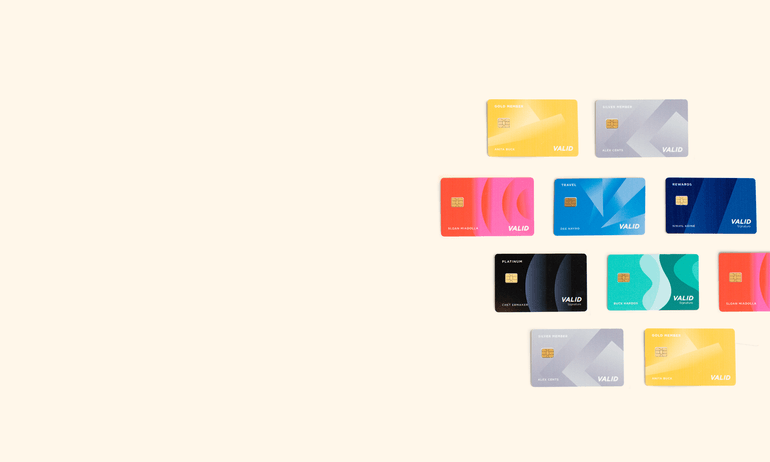2019 Consumer Credit Card Report
Credit card interest rates have increased 35% over the past five years, and it’s costing Americans: Nearly half of consumers are paying less than their full credit card bill each month. See how small APR increases can add up to thousands of dollars in interest charges and learn how to pay your debt off faster when rates go down.

Many or all of the products on this page are from partners who compensate us when you click to or take an action on their website, but this does not influence our evaluations or ratings. Our opinions are our own.

Credit card interest rates have risen substantially over the past few years, and even though the Federal Reserve just moved to lower rates slightly, the accumulated increases may have already cost many households thousands of dollars in interest on credit card debt, a new NerdWallet analysis shows.
NerdWallet’s annual Consumer Credit Card Report is our in-depth examination of the credit card landscape and its impact on consumer finances. In last year’s report, we looked at the rise in delinquent credit card debt and the costs associated with it.
For 2019, we analyzed the most recent data on credit card interest and delinquency rates from the Federal Reserve of St. Louis to see how much the average credit card interest rate has gone up in the past five years. We also ran a survey, conducted online by The Harris Poll, of more than 2,000 U.S. adults to see how much they prioritize interest rates when choosing a credit card. We asked Americans about how they pay their monthly credit card bill and found that nearly half don’t pay in full each month, which means they’re bearing the expense of higher rates.
This is the 2019 edition of NerdWallet's annual Consumer Credit Card Report. For other editions and more research, see our credit card data page.
Our report dives into the costly reality of higher interest rates and delinquent payments, as well as Americans’ knowledge of their personal credit cards’ APRs and their plans for the “extra money” that could end up in their budgets as interest rates drop.
Key findings
Many cardholders pay less than their full balance. Almost half of Americans who have credit cards (47%) don’t pay off their balance in full each month, according to our survey. Most credit cards charge interest only when you carry a balance, and these cardholders could be paying thousands of dollars more in interest.
Consumers don’t know their credit cards’ interest rates — or what those rates should be. About 2 in 5 Americans who have personal credit cards (38%) don’t know the interest rates on all of them. Even if they do know, the value of that knowledge is likely limited, as 44% of American cardholders don’t know what interest rate is reasonable for their credit score.
Late credit card payments may be costing Americans billions. More than a quarter of Americans (26%) have made a delinquent credit card payment (30 or more days late), and 12% have made multiple delinquent payments. According to NerdWallet’s analysis, the late fees alone on these delinquent payments top $3 billion. [1] And that doesn’t include the interest charges accrued from carrying a balance.
As interest rates go down, consumers say they’ll use the savings to pay down credit card debt. Over 2 in 5 Americans who ever pay interest on their credit cards (44%) say that if their interest rate were decreased, they would use the money saved on interest payments to pay down credit card debt. And they should, because it could save them time and money.
Americans pay the price for higher interest rates
Credit card interest rates are notoriously high — among the highest rates on any consumer debt. In the past five years, the average rate on credit card accounts that accrued interest has risen from 12.74% to 17.14%. A change of 4.4 percentage points may not seem big, but in this case it represents a 35% increase. That adds significantly to the interest costs for consumers who carry credit card debt from month to month.
How much can it add? Say a consumer has a credit card balance of $10,000 and makes only the minimum payment each month without adding to the balance. At the average rate from 2014, it would have taken 279 months to pay off this balance and would have cost $9,829 in interest. At the average rate from the first part of 2019, it would take 289 months and cost $13,347 in interest. That’s a difference of 10 months and more than $3,500 in interest charges. [2]
Americans are split on their preference for credit card rewards vs. lower interest rates
Considering the rise in interest rates, our survey asked Americans whether they would choose to apply for a rewards credit card — which offers cash back, points or miles based on their purchases — or a credit card with a lower-than-average interest rate. Half said they would opt for a lower interest credit card, while half said they would choose a rewards card. Americans are slightly more likely to say rewards are the most important factor when deciding which credit card to apply for than interest rate (33% vs. 29%).
Generationally, 33% of millennials (ages 23-38) and 34% of Gen Xers (ages 39-54) say APR is the most important factor when deciding which credit card to apply for, compared with 24% of baby boomers (ages 55-73), the survey found.
Boomers are more likely to say rewards or a card’s annual fee is the most important factor — 40% picked rewards as the top factor, compared with 29% of millennials and 31% of Gen Xers, and 24% of boomers pointed to the annual fee, compared with 14% of millennials and 18% of Gen Xers.
“The more credit card debt you have, the more important it is to look into lower-interest credit cards, or even balance transfer cards with an introductory 0% interest period. Make it as inexpensive as possible to pay off your debt,” says Sara Rathner, NerdWallet’s credit card expert. “Get that balance down to zero before you focus on earning rewards. When you carry a balance from month to month, you pay more in interest than you earn in rewards.”
A slim majority of Americans who have credit cards (53%) pay their credit card bill in full each month, which means the other 47% are probably paying interest.
According to our survey, millennials are less likely than boomers to pay off their balance in full each month — 42% of those with credit cards, compared with 63% of boomers — which makes their preference for lower-interest credit cards (56%) over rewards credit cards (44%) a good choice. Cardholders should aim to pay off their entire balance by the due date each month, since doing so avoids interest. But if that’s not possible, reducing interest costs is the next best thing.
More than 1 in 10 Americans who have credit cards (11%) make only the minimum payment on their credit card bill. This is more common for younger generations — 17% of Gen Zers (ages 18-22) and 16% of millennials who have credit cards, compared with 6% of boomers. While making the minimum required payment is enough to keep an account in good standing, it usually means paying hefty interest charges.
About a third of Americans with credit cards (34%) make a payment higher than the minimum, but less than the full balance. This is a better option than just paying the minimum because interest costs are assessed on the average daily balance throughout the month, so the lower that daily average, the lower the interest charges.
More than 2 in 5 Americans don’t know what their interest rate should be
Over three-quarters of Americans who have credit cards (77%) have paid interest on those credit cards, but many are in the dark about their interest rates and how much they pay in interest each month, the survey found. About 2 in 5 Americans who have credit cards (38%) don’t know the interest rate on all of their personal cards and more than a quarter (26%) don’t know the dollar amount of interest they pay on them each month.
Knowing a card’s interest rate — you can find yours on your monthly credit card statement — can provide powerful motivation to pay it off, but ideally anyone regularly paying credit card interest is using a card with a lower-than-average APR or one with a 0% introductory rate. Close to half of Americans who have a credit card (44%) don’t know what a reasonable interest rate for their credit score is, so they may be overpaying.
Delinquent credit card payments cost Americans at least $3 billion in fees
Higher interest rates aren’t the only way credit cards have gotten more costly in recent years; delinquencies are up 22% since 2015. [3] For purposes of this report, we define a credit card delinquency as a payment that is 30 or more days late.
More than a quarter of Americans (26%) have ever made a delinquent payment, with 12% paying late more than once, according to our survey. If those who have repeatedly paid late did so only twice, the total late payment fees would add up to more than $3 billion. [1] It’s likely that some Americans have made many more delinquent payments, so this is a conservative estimate.
Americans say they would pay down credit card debt with any savings from lower rates
Interest rates go up and down. After several years of increases, the Federal Reserve voted in July 2019 to reduce the federal funds rate by one-quarter of a percentage point. That will have a domino effect on other interest rates, including on credit cards, although those rates may take a while to drop. Our survey asked Americans who pay interest on credit cards what they would do with the money saved from lower interest payments, and many of them say they would use it to pay down their credit card debt or boost their savings.
More than 2 in 5 Americans who ever pay interest on their credit cards (44%) say they would put any interest saving toward paying down their balance more quickly. This could make a huge difference, even with seemingly minor rate drops.
Let’s look again at the earlier scenario, a consumer with $10,000 in credit card debt who isn’t adding to the balance and makes the minimum payment each month. In this case, interest rates go down by a full percentage point, taking the average from 17.14% to 16.14%.
The cardholder could adjust their minimum payments down to the lower amount dictated by the new interest rate. But what if they kept paying the same amount they were paying with the 17.14% rate? This consumer would save over $4,700 in interest costs and a full 12 years of payments. [4] Because the interest rate is lower, more of the payment goes toward the principal, drastically bringing the balance down, which in turn results in less interest being charged.
About 1 in 10 Americans who ever pay credit card interest (9%) say they would put the saved money toward paying down other non-credit card debt, while around a quarter (24%) say they would put it in savings. These are both good options from a personal finance perspective, but once they have some savings — we recommend stashing three to six months worth of expenses in case of an emergency — it’s a good idea to tackle high interest credit card balances.
Consumer takeaways
If you plan to carry credit card debt, a lower interest rate should be a higher priority than rewards. Credit cards that offer rewards on your spending make financial sense only if you pay off your balance every month. Many of the best rewards credit cards max out at a rewards rate of about 2%. This is a great bonus if you’re avoiding interest charges, but otherwise, it’s not worth it. You won’t earn enough rewards to outweigh the interest costs.
“Take advantage of lower interest rates to get out of debt more quickly,” Rathner says. “Any extra amount of money you’re able to put toward your credit card debt each month will save you months or even years of debt repayment and can save you thousands of dollars in interest.”
Late credit card payments can result in high fees, but that’s not the only cost. Late fees are expensive, especially for cardholders who pay late more than once. Delinquent payments may also result in higher interest rates, called penalty APRs, for a certain period while you demonstrate that you can make your payments on time.
In addition to these costs, delinquent payments can hurt your credit score. Payments that are late by 30 days or more are often reported to the credit bureaus and end up on your credit report, where they stay for seven years. The information on your credit report is used to determine your credit score, which in turn impacts whether you’re able to qualify for credit and affects your interest rates. Even if you can afford only the minimum payment, it’s important to make it to avoid fees, higher interest rates and dings to your credit score.
Resist using a lower interest rate as an excuse to spend more. As rates go down, it should get you out of debt faster, not dig you in deeper. Even keeping your payments the same as they would have been if you kept paying the minimum monthly payment with a higher interest rate could save you hundreds or thousands of dollars and many months of payments.
“Interest rates ebb and flow, and even if rates go down slightly, you can’t expect them to stay that way forever,” Rathner says. “Prioritize high interest credit card debt — and it’s pretty much all high interest — and pay it down to avoid being at the mercy of the Fed.”
Methodology
The survey was conducted online within the U.S. by The Harris Poll on behalf of NerdWallet from June 20-24, 2019, among 2,021 U.S. adults ages 18 and older. Of that total, 1,718 have credit cards. This online survey isn’t based on a probability sample and therefore no estimate of theoretical sampling error can be calculated. For complete survey methodology, including weighting variables and subgroup sample sizes, contact [email protected].
NerdWallet’s analysis includes data from the following sources:
Commercial Bank Interest Rate on Credit Card Plans, Accounts Assessed Interest, May 2019, from the Federal Reserve Bank of St. Louis.
Delinquency Rate on Credit Card Loans, All Commercial Banks, Q1 2019, from the Federal Reserve Bank of St. Louis.
Late payment fees, December 2018, from the Consumer Financial Protection Bureau.
QuickFacts, July 2018, from the U.S. Census Bureau.
FOOTNOTES
[1] We calculated our $3 billion figure by taking the most recently reported adult U.S. population from the U.S. Census Bureau multiplied by the 26% of Americans who said they had made a delinquent payment. We multiplied that amount by $28, the maximum first-time late payment fee. We added that to the U.S. adult population multiplied by the 12% of Americans who made more than one late payment, multiplied by $39, the maximum late payment fee for a second late payment made within six billing cycles.
[2] We calculated interest costs on a $10,000 balance by assuming minimum payments of 1% of the balance plus the interest accrued each month, or $25, whichever was higher. We used average interest rates from the Federal Reserve Bank of St. Louis for May 2014 and May 2019 (the most recently reported average) to compare the difference between now and five years ago.
[3] We calculated the delinquency rate increase by taking credit card delinquency rates from the Federal Reserve Bank of St. Louis from the first quarter of 2015 and 2019 (the most recently reported data) to compare the difference between now and four years ago.
[4] We calculated interest costs on a $10,000 balance by assuming minimum payments of 1% of the balance plus the interest accrued each month, or $25, whichever was higher. We used the average interest rate from the Federal Reserve Bank of St. Louis from May 2019 (the most recently reported average). To figure out how interest costs would change if rates went down, we subtracted 1 percentage point from the interest rate, but didn’t change the minimum payments to create a scenario where a consumer was still paying minimum payments on the original interest rate.
Find the right credit card for you.
Whether you want to pay less interest or earn more rewards, the right card's out there. Just answer a few questions and we'll narrow the search for you.





